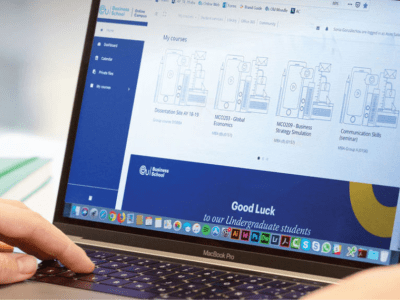Marco Scabioli is the Growth Marketing Manager at German start-up Flixbus, which was founded in 2013. In his current role, he is responsible for attracting and retaining customers through diverse marketing campaigns.
Marco’s work at Flixbus has spanned affiliate, social media and mobile marketing, perfectly placing him in a position to address EU Business School students on the importance of online marketing in the travel industry.
Flixbus Business Vision
Flixbus was defined by Marco as a combination of a tech start-up, an online platform and a transportation company. It allows customers to travel cheaply in more than 35 countries. The Flixbus vision is to provide smart and green mobility that allows everyone to explore and experience the world. This vision is based on four crucial pillars of the service:
- It’s smart
Flixbus offers the best value-for-money and the most convenient booking process possible. - It’s green
The Flixbus fleet is eco-friendly due to lower greenhouse gas emissions. - It’s for everyone
Flixbus is accessible to a broad audience that includes millions of passengers. - It’s an experience
Flixbus offers an excellent travel experience for customers so they can enjoy exploring new places.
Flixbus Business Model
In 2013, there was a liberalization of the bus market in Germany. Founders of Flixbus identified an opportunity to make bus travel more attractive. The pre-existing model of bus transportation was very inflexible and old-fashioned. Instead, founders wanted to showcase buses as an alternative form of transport that was both economical and eco-friendly.
To do this, they designed a unique business model based on partnership. Flixbus does not own the buses that they use; instead, they are in partnership with owners. What they do is support bus owners with marketing, branding, pricing and business strategies.
Flixbus serves over 2,000 destinations and has over 500 network partners. There are 3,000 Flixbus employees and over 10,000 drivers providing the Flixbus service. Although Flixbus had a lower marketing budget initially when compared to their competitors, the company has nonetheless achieved significant success. Marco attributes this success to three factors:
- The unique business model
- Experienced business partners who brought their own extensive networks
- Great tech support that gathers data to inform all decision-making
Before the COVID-19 pandemic struck, Flixbus was successfully expanding in two directions: market expansion and products. The company was consolidating its presence in new markets such as the U.S.A. They were also broadening their offer with the introduction of the Flixtrain service.
Flixbus Marketing Philosophy
Marco explained to students that the marketing process at Flixbus is very different from what they might expect. In fact, it is much more about analyzing data rather than creating fancy content. The overriding philosophy is that the role of marketing is to generate traffic via different channels and convert it into orders as efficiently as possible. Efficiency is the key word.
Different channels are used for different purposes. Some may be used to inspire new customers, whereas others are used to close sales. Before deciding to invest in a channel, the marketing team tests its key performance indicators. Part of this is understanding marketing attribution: gathering knowledge regarding which touchpoints contributed to final purchases and to what extent.
How Does Search Engine Advertising Work?
Search engine advertising is one of the most important channels, according to Marco. By paying for ads, you can increase your visibility on a search engine. Ads are displayed when a search matches the keywords that you have paid to advertise on.
However, not just any page can advertise here. Firstly, Google has to assess the quality of your page. An auction, which considers how much you are able to pay alongside your quality rating, takes place. This is how Google determines which advertisements will be shown.
Search engine advertising is a useful tool for targeting what Marco described as “low hanging fruit,” for example, people who you already know are looking at travel options in a city served by Flixbus. This channel is one of the biggest sources of traffic to the Flixbus website.
Other advantages of search engine marketing include the auction process as an opportunity to study the marketing strategies of competitor companies and the fact that you can start and stop campaigns easily. You can also obtain a great deal of data from this channel.
SEO: Why Is It Important?
Unlike advertising, SEO is a free way to engage customers’ attention. By optimizing content, you can place your page higher according to Google’s rankings, making it far more likely for your target audience to click on and thus pay a visit to your high-ranking website.
To optimize your page, you must ensure that you are using relevant keywords and that your page is identified as relevant and authoritative by the Google scanner. Google results reflect the ranking that is assigned to your page.
How to Use Display Ads
Display ads may be shown on other sites or on applications. To determine whether it is a worthwhile investment, you must find out how many people actually interact with your product after viewing your ad.
Using Flixbus as an example, Marco explained that, in order to use display ads effectively, he may try targeting two different audiences at the same time; for example, football sites and travel blogs. After doing this, he can easily compare which is performing better and thus hereafter decide where it makes more sense to continue directing marketing money towards.
Making the Most of Social Media
There are two kinds of social media marketing. The first is organic, where you post content such as travel inspiration or customer stories. The second kind is paid. By using paid advertisements, you can target people based on demographics and particular interests, making it a highly personalized form of social media marketing.
Other ways you can use social media is to communicate with users and build relationships with them through competitions and sharing news. You can also receive direct feedback through comments and private messages. Lastly, social media offers the opportunity to analyze your user base and understand the demographic of your customers.
The Role of Customer Relationship Management
Marco emphasized the importance of retaining customers. He advised that, in order to do so, companies must talk to them in the best way possible. This means using a range of mediums: push notifications, email and SMS are just some examples. It also means gathering data so that you are well-informed about what the customer wants.
In the case of Flixbus, customers are segmented based on what they use the service to do. Commuters have very different priorities from globetrotters who are planning a vacation. By splitting them into groups, Flixbus avoids spamming them with irrelevant information. They are instead able to launch dynamic email campaigns based on the customer’s previous actions.
During the pandemic, Flixbus started an initiative called Flixdeal which allowed customers to purchase discounted vouchers for future travel. This is one example of how a company may retain customers, even during a moment of crisis.










